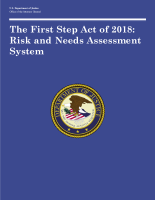Prisons
NIJ Journal Issue No. 257
Solutions in Corrections: Using Evidence-based Knowledge
Professor Ed Latessa describes how his team and he assessed more than 550 programs and saw the best and the worst. Professor Latessa shared his lessons learned and examples of states that are trying to use evidence-based knowledge to improve correctional programs.
See the YouTube Terms of Service and Google Privacy Policy
Less Prison, More Police, Less Crime: How Criminology Can Save the States from Bankruptcy
Professor Lawrence Sherman explains how policing can prevent far more crimes than prison per dollar spent. His analysis of the cost-effectiveness of prison compared to policing suggests that states can cut their total budgets for justice and reduce crime by reallocating their spending on crime: less prison, more police.
See the YouTube Terms of Service and Google Privacy Policy
Going Home (or Not): How Residential Change Might Help the Formerly Incarcerated Stay Out of Prison
Dr. Kirk discusses how Hurricane Katrina affected those formerly incarcerated persons originally from New Orleans and their likelihood of returning to prison. Kirk also discussed potential strategies for fostering residential change among those who were incarcerated, focusing specifically on parole residency policies and the provision of public housing vouchers.
See the YouTube Terms of Service and Google Privacy Policy
Changing the Behavior of Drug-Involved Offenders: Supervision That Works
A small number of those who commit crimes are heavily involved in drugs commit a large portion of the crime in this country. An evaluation of a "smart supervision" effort in Hawaii that uses swift and certain sanctioning showed that individuals committing crimes who are heavily involved in drug use can indeed change their behavior when the supervision is properly implemented.
See the YouTube Terms of Service and Google Privacy Policy
Benefit-Cost Analysis for Crime Policy
How do we decide how to allocate criminal justice resources in a way that minimizes the social harms from both crime and policy efforts to control crime? How, for that matter, do we decide how much to spend on the criminal justice system and crime control generally, versus other pressing needs? These questions are at the heart of benefit-cost analysis.
See the YouTube Terms of Service and Google Privacy Policy
Reforming New Orleans' Criminal Justice System: The Role of Data and Research
With its criminal justice system in disarray following Hurricane Katrina, New Orleans invited the Vera Institute of Justice to examine the city's court and jail operations. For five years, Vera has been tracking arrest-to-first-appearance time, custodial arrests versus summonses, the granting of pretrial release, and many other decision-making points. Based on analysis of these data, Vera is making policy recommendations to assist with the implementation of new procedures and to ensure performance monitoring.
Just Wrong: The Aftermath of Wrongful Convictions
The strength of our criminal justice system depends on its ability to convict the guilty and clear the innocent. But we know that innocent people are sometimes wrongfully convicted and the guilty remain free to victimize others. The consequences of a wrongful conviction are far-reaching for the wrongfully convicted and the survivors and victims of the original crimes.
See the YouTube Terms of Service and Google Privacy Policy
Alternative Sentencing Policies for Drug Offenders
The panel presentations from the 2009 NIJ Conference are based on an NIJ-sponsored evaluation of the effectiveness of Kansas Senate Bill 123, which mandates community-based drug abuse treatment for drug possession by nonviolent offenders in lieu of prison.
"Getting Ready Program": Remaking Prison Life to Prepare Inmates for Reentry
Interview with Dora Schriro, Arizona Department of Corrections
Cell Phones in Prison
Criminals are using cell phones illegally in prisons and jails to conduct their business and intimidate witnesses. Although technology solutions to this problem are available, they can create new challenges, such as legal and implementation issues associated with cell phone use in correctional facilities. Panelists will discuss various aspects to consider from how prisoners use cell phones, to day-to-day and operational aspects, to legal and regulatory concerns.
Discussing the Future of Justice-Involved Young Adults
New science in brain development is transforming young adult involvement with the justice system. On Tuesday, September 8, Attorney General Loretta Lynch, Assistant Attorney General Karol Mason, and experts from NIJ and the Harvard Kennedy School Program in Criminal Justice who serve on the Executive Session on Community Corrections discussed the future of justice-involved young adults.
See the YouTube Terms of Service and Google Privacy Policy
An Examination of Justice Reinvestment and Its Impact on Two States
Funded in part by the Bureau of Justice Assistance and the Pew Center on the States, the justice reinvestment project is a data-driven strategy aimed at policymakers to "reduce spending on corrections, increase public safety and improve conditions in the neighborhoods to which most people released from prison return." Representatives from two states where the justice reinvestment strategy is currently being implemented will discuss how it is being used to reduce the rate of incarceration and how states can reinvest in local communities.
Notes from the Field: Prison Reform Reducing Restrictive Housing for Improved Prison Outcomes
What Works in Probation and Parole
How can we prevent reoffending and reduce costs? Research points to a number of solutions. At the Tuesday plenary, Judge Steven Alm from Hawaii will describe his successes with hard-core drug offenders. “Swift and sure” is his motto. West Virginia Cabinet Secretary James W. Spears will discuss the issues from his state's perspective, and Adam Gelb, Director of the Pew Charitable Trust's Public Safety Performance Project, will lend a national overview.
What Works in Offender Supervision
This NIJ Conference Panel highlights findings from NIJ projects that evaluated strategies to enhance the supervision of offenders in the community. Researchers discuss the effectiveness of fair, swift and certain sanctions for high-risk probationers in the Hawaii HOPE program. Panelists also provide empirical evidence on the effectiveness of electronic monitoring — including the use of GPS tracking — for medium- and high-risk offenders on supervision and upon completion of their supervision sentence.


